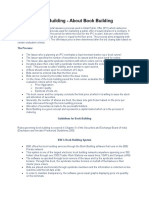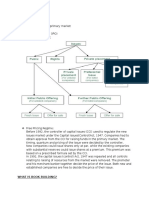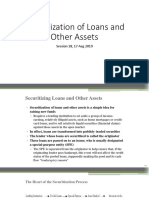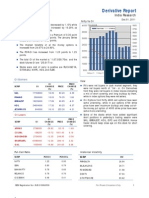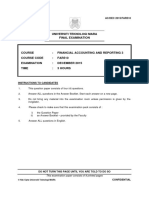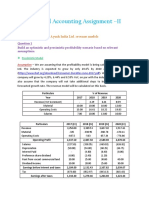0 ratings0% found this document useful (0 votes)
27 viewsBook Building
Book Building
Uploaded by
vineet ranjanBook building is a process by which companies determine the price and quantity of shares to be issued in an IPO. Investors submit bids indicating the price they are willing to pay and the quantity of shares wanted. The lead manager collects these bids and sets the issue price, usually at a level where demand matches the quantity of shares issued. Shares are then allotted to successful bidders at the issue price. The process involves appointing a lead manager, filing prospectus documents, collecting bids, setting the price, and allotting shares. It allows companies to gauge market demand and price shares appropriately.
Copyright:
© All Rights Reserved
Available Formats
Download as PPT, PDF, TXT or read online from Scribd
Book Building
Book Building
Uploaded by
vineet ranjan0 ratings0% found this document useful (0 votes)
27 views40 pagesBook building is a process by which companies determine the price and quantity of shares to be issued in an IPO. Investors submit bids indicating the price they are willing to pay and the quantity of shares wanted. The lead manager collects these bids and sets the issue price, usually at a level where demand matches the quantity of shares issued. Shares are then allotted to successful bidders at the issue price. The process involves appointing a lead manager, filing prospectus documents, collecting bids, setting the price, and allotting shares. It allows companies to gauge market demand and price shares appropriately.
Copyright
© © All Rights Reserved
Available Formats
PPT, PDF, TXT or read online from Scribd
Share this document
Did you find this document useful?
Is this content inappropriate?
Book building is a process by which companies determine the price and quantity of shares to be issued in an IPO. Investors submit bids indicating the price they are willing to pay and the quantity of shares wanted. The lead manager collects these bids and sets the issue price, usually at a level where demand matches the quantity of shares issued. Shares are then allotted to successful bidders at the issue price. The process involves appointing a lead manager, filing prospectus documents, collecting bids, setting the price, and allotting shares. It allows companies to gauge market demand and price shares appropriately.
Copyright:
© All Rights Reserved
Available Formats
Download as PPT, PDF, TXT or read online from Scribd
Download as ppt, pdf, or txt
0 ratings0% found this document useful (0 votes)
27 views40 pagesBook Building
Book Building
Uploaded by
vineet ranjanBook building is a process by which companies determine the price and quantity of shares to be issued in an IPO. Investors submit bids indicating the price they are willing to pay and the quantity of shares wanted. The lead manager collects these bids and sets the issue price, usually at a level where demand matches the quantity of shares issued. Shares are then allotted to successful bidders at the issue price. The process involves appointing a lead manager, filing prospectus documents, collecting bids, setting the price, and allotting shares. It allows companies to gauge market demand and price shares appropriately.
Copyright:
© All Rights Reserved
Available Formats
Download as PPT, PDF, TXT or read online from Scribd
Download as ppt, pdf, or txt
You are on page 1of 40
Book Building
Concept and the Processes.
Introduction
Book Building is a process by which the
Corporates determine the demand and the
price of a proposed issue on the basis of the
price book-built. Once the price and the
quantum of the issue has been determined by
the issuer, the issue may be offered under the
private placement or public offer or both as per
the SEBI regulations.
Characteristics
Tendering Process :
Eligible investors are required to place their
bids for the number of shares to be issued and
the price at which they are willing to invest,
with the lead manager running the book.
At the end of the cut-off period, the lead
manager determines the response to the issue
in terms of the quantum of shares and the highest
price at which the demand is sufficient to match the
size of the issue.
Characteristics
Floor Price:
It is the min. price set by the lead manager in
consultation with the issuer. This is the price
at which the issue is open for subscription.
Investors are free to place a bid at any higher
price than the floor price.
Characteristics
Price Band:
The range of price( The highest and the lowest)
at which offer for subscription of securities is made.
Investors are free to bid any price within the price
band.
Bid:
Investor can place a bid with the authorized lead
manage-merchant banker.
Characteristics
Bids Contd.
In case of the equity shares usually banks and
some leading stock brokers are also authorized
by the lead manager.. Investor can give bid for
up to three optional prices. The price and
demand options submitted by the bidder are
treated as optional demands and are not
cumulated.
Characteristics
Allotment:
Lead Manager, in consultation with the issuer
decides the price at which the issue will be
subscribed and proceeds to allot shares to
investors who have bid at or above the fixed
price. All investors are allotted shares at the
same fixed price. For any allottee, the price
would be equal to or less than the price bid.
Characteristics
Participants:
Generally, all investors including
individuals are eligible to invest in a particular
issue of securities and can participate in book-
building process. However if the issue is
restricted to Qualified Institutional Investors,
as in the case of g sec., then only those
eligible can participate.
Book Building Process
Process of Book- Building is as under:
a) Earmarking Securities
b) Finding Price Band
c) Filing Red-herring prospectus
d) Filing Draft Prospectus
e) Appointment of Book-Runners
f) Collecting Price Bids
g) Price Setting
Book Building Process
h) Public Subscription
i) Underwriting
j) Bank Account
k) Allotment
l) Listing
m) SEBI Inspection
Book Building Process
A) 75 percent Book Building.
The 75% book building option of securities
is offered on a firm basis where a minimum
of 25 % 0f the securities is offered to the
public. Following steps are involved:
i) Eligibility : All Companies eligible for
public shares are eligible for raising capital
through the book building process.
Book Building Process
ii) Earmarking of Securities:
The securities to be separately marked as
placement portion category and balance as net
offer to the public.
iii)Draft Prospectus: A DP containing all
information with indicative price band to be
filed with SEBI. Within 2 days of finalizing
issue price, DP is to be filed with the ROC.
Book Building Process
iv) Appointment of Book Runner.
Issuing Co. appoints a Merchant Banker as
the Book Runner. BR circulates a copy of the
Draft Prospectus to Institutional Buyers who
are eligible for firm allotment and to the
intermediaries who are eligible to act as
underwriters, inviting them to subscribe to the
issue.
Role Of Book Runner
The Book Runner maintains a record of the names and
no. of securities ordered by intermediary buyers and
the price at which they are willing to subscribe the
issue under the placement portion.
The Book Runner collects information about the
subscriptions received from underwriters and other
intermediaries. After the stipulated time period, the
Book Runner aggregates the subscriptions so
received.
The underwriters are required to make a payment of
the total amount for subscription of issues.
Role of Book Runner
The Book Runner collects payments from the
underwriters and institutional buyers a day
prior to the opening of the issue to the public,
which includes application money for all the
applications through which securities were
subscribed by them
Price Setting
Based on the data collected from intermediaries relating to the
total orders received, the issuing Co. and the Book Runner, set
an appropriate price of the issue for offer to the public. The
issue price is determined on the basis of Bids received through
members of the syndicate formed under the lead book runner.
This would be the issue price for both the private placement
and the public category. The no. of securities to be issued is
decided on the basis of the amount and the issue price and is
expressed as under:
No. of securities: Amt of issue/price per security.
Underwriting
The members of the syndicate fully underwrite
the offer to the extent that is not offered to the
promoters, permanent employees and
shareholders.
For this purpose, the syndicate members enter
into an underwriting agreement which
specifies the quantum and price of shares that
would be underwritten for book building.
Underwriting
Underwriting is mandatory for issues that are
earmarked as net offer to the public. Underwriters
maintain a record for the subscriptions received by
them for the issue in the placement portion and
forward these records to the book runner. In the event
of the underwriters not being in a position to take up
the shares as committed, the book runners have to
subscribe to the issues committed for by the
underwriters.
Bank Account
Bank Account:
The issuer Company opens two
Accounts, one for collection of the applications
Towards the private placement and the other for
The offer of the 25 % of the total issue to the
Public.
Allotment
All those intermediaries who have offered their
Bid price at and above the now determined price
Will become eligible for allotment .Once the
eligibility is decided ,intimation will be sent to
them for subscription and payment.
Although, the allotment un the private placement
category has to be made two days prior to the
date of closure of the issue, the issuer may choose
Allotment
to allot securities under the process for both
under private placement and under the public
category on the same day in accordance with
SEBI guidelines. In the event of any under
subscription to the public offer category, orders
in the private placement category can be utilized to
fill public subscription .While doing so preference
should be given to individual investors.
Allotment
Similarly, when there is a deficient subscription
in
the private placement category, a spill over is
allowed from public offer category. Interest is
payable by the issuer between the date of closure
to the date of allotment.
Listing
When all the committed money has been
collected from the underwriters by the 11 th day
of closure of the issue, the shares allotted in
the private placement category and public offer
become eligible for listing. However securities
offered online over the internet are not listed.
Inspection
SEBI serves as the chief regulator supervising
the
Book building process. It has the powers to
carry
out the inspection of books and records
Maintained by intermediaries such as the book-
Runner, the underwriters and others.
100 % Book Building
It is an option of book-building process of the
Securities whereby 100% of the securities is
offered on a firm basis, or is reserved for the
Promoters, permanent employees of the issuer
Company. It may also be offered to the share
Holders on a competitive basis or on a firm
allotment basis..
100% Book Building
Conditions:
a) Min. capital to be raised is Rs. 25 Cr.
b) Reservation of firm allotment to promoters and
permanent employees only as per SEBI guidelines and in case
of new companies to
the permanent employees of the promoting co.
c) Allotment can be made on firm or competitive
basis to shareholders of promoting co. and
group companies.
d) Eligible merchant bankers to be appointed as the lead book
runners and their names to be stated in the prospectus to be
filed with SEBI.
Lead Book Runner
This is an essential requirement.
Lead Book Runners is responsible for book
Building in order to determine the appropriate
Price and quantum of issue. For this purpose
A syndicate is formed consisting of SEBI
registered underwriters and other eligible
merchant members. In the event of any
under subscription,
Lead Bank Runner
the lead merchant bankers have to fill the
shortfall. The Book Runners are responsible
for maintenance of records and for incorporating
any changes in the draft prospectus as suggested
by SEBI, besides maintenance of records of
Book building process which may be inspected
By SEBI.
Draft Prospectus
The lead Book Runner files a draft prospectus
with SEBI. This document contains all the
required disclosures such as the total size etc. in
accordance with SEBI norms. Any modification
In the draft prospectus are to be intimated by the
Co. to SEBI within 21 days after receipt of the
Draft Prospectus by SEBI.
Essential Disclosures
Details of:
Syndicate members selected by the
lead book runner for the purpose pf bidding
of the issue.
b) Registrars and Bankers to the issue.
c) Basis of issue price
d) Accounting ratios such as pre issue
EPS, P/E etc
e) NAV per share based on the last B/S.
Advertisement
a) The issuer, after obtaining the revised
prospectus from SEBI, advertises in leading
newspapers.
b) The advertisement contains all the features
of
the final offer document. (Sec 2A Co Act)
c) It is incumbent for the issuer to offer at least
10% of the total issue to the public.
Stock Brokers
SEBI registered stock brokers are appointed for
placing orders with the Co. by the stock
exchange
that would act as collection centers. These stock
brokers must be capable of taking up the issue in
the event of any failure. The issuer pays them
commission for their services.
Bidding Process
a) Advertisement is issued regarding
bidding ,date of opening ,closing, name
and address of syndicate members , bidding
terminals and the method of bidding,
b) Bidding takes place on-line electronically by
the members present at designated centers.
c) No. of collection centers and bidding centers
is as per SEBI guidelines.
Bidding Process
d) Individuals and institutions who are not the
members can bid through the syndicate
members.
e) Bidding is done in the prescribed form giving
information on investor, price and quantum of
securities.
f) The Serial No of bidding form is system
generated and stamped automatically.
Bidding Process
g) The Bidding form is made in duplicate and is
counter signed by the book runner/syndicate
member.
Allotment Process
a) Min. 15% reserved for allotment to individual
investors to a max. of 10 trade able lots through
the syndicate member.
b) Min. of 10% is reserved to individual investors
who have not participated in the book building
process.
c) Allotment to individual investors to be on the
basis of a proportionate allotment system.
Allotment Process
d) In event of under subscription of issue reserved
for individual investors, issuer may make allotment as
it deems fit.
e) Allotment to other categories shall be decided
by the Book Runner on the basis of price
commitment, investor category, price quoted etc.
f) Allotment is to be made within 15 days of closure.
Interest @ 15 % in event of default. Issue to remain
open for at least 21 days.
Refund
The refunds shall be made by the brokers to
unsuccessful applicants within 3 days of the
receipt of the allocation. The details of amount
received from successful applicants shall be
furnished to the stock exchange in electronic
medium.
Issue of Share Certificates
Once all the formalities for subscription are
allotment are completed, the registrars to the
issue will post the share Certificates to the
successful candidate or arrange to have the
shares to the applicants in demat form.
Conclusion
Thank You
You might also like
- AP Macroeconomics Practice Exam 1Document12 pagesAP Macroeconomics Practice Exam 1Nguyễn Phương LiênNo ratings yet
- Book BuildingDocument24 pagesBook Buildingmariam_abbasi5100% (2)
- Nanyang Business School AB1201 Financial Management Seminar Questions Set 4: Bonds and Their Valuation (Common Questions)Document3 pagesNanyang Business School AB1201 Financial Management Seminar Questions Set 4: Bonds and Their Valuation (Common Questions)cccqNo ratings yet
- Concepts and Process of Book BuildingDocument4 pagesConcepts and Process of Book BuildingGopalsamy SelvaduraiNo ratings yet
- Capital Market - Part-6 - Book Building and Buy-BackDocument7 pagesCapital Market - Part-6 - Book Building and Buy-Backenvim66No ratings yet
- Ipo Book Bldg.Document32 pagesIpo Book Bldg.Akanksha RajanNo ratings yet
- Overview and Executive SummaryDocument61 pagesOverview and Executive SummaryAkshay SableNo ratings yet
- FinalDocument29 pagesFinalapi-3732797No ratings yet
- What Is It Book BuildingDocument5 pagesWhat Is It Book BuildingPratik N. PatelNo ratings yet
- Project Report: Public Issue (Book Building Method)Document21 pagesProject Report: Public Issue (Book Building Method)Saurabh BandekarNo ratings yet
- Book Building of Equity SharesDocument20 pagesBook Building of Equity Sharesdhiman.saurabhNo ratings yet
- Analysis On Public IssueDocument21 pagesAnalysis On Public IssueSaurabh BandekarNo ratings yet
- Book BuildingDocument19 pagesBook Buildingmonilsonaiya_91No ratings yet
- Material Primary MarketDocument4 pagesMaterial Primary MarketAbhisek RanaNo ratings yet
- IpoDocument3 pagesIpoVinod GudimaniNo ratings yet
- Book Building MechanismDocument18 pagesBook Building MechanismMohan Bedrodi100% (1)
- Book BuildingDocument2 pagesBook BuildinghmgamitNo ratings yet
- Book BuildingDocument3 pagesBook Buildingrupika_borntowin2No ratings yet
- Book Building of Equity SharesDocument20 pagesBook Building of Equity Sharessneha_rulz157757No ratings yet
- Initial Public OfferDocument29 pagesInitial Public OfferAjay MadaanNo ratings yet
- Primary Issue: What Is Book Building?Document9 pagesPrimary Issue: What Is Book Building?mitalptNo ratings yet
- About Public Issues: More About Book BuildingDocument6 pagesAbout Public Issues: More About Book BuildingBalaji RavigopalNo ratings yet
- Issue Type Offer Price Demand Payment ReservationsDocument14 pagesIssue Type Offer Price Demand Payment ReservationssmileysashiNo ratings yet
- Functions of Capital MarketDocument23 pagesFunctions of Capital MarketPalha KhannaNo ratings yet
- Ipo ProcessDocument3 pagesIpo ProcessDrApurva ChauhanNo ratings yet
- Bombay Stock ExchangeDocument10 pagesBombay Stock Exchangeaddy9760No ratings yet
- What Is An Initial Public OfferDocument4 pagesWhat Is An Initial Public OfferGadmali YadavNo ratings yet
- Security Analysis and Portfolio Management: Presented By, Saitha MeeranDocument8 pagesSecurity Analysis and Portfolio Management: Presented By, Saitha Meeransaidha meeranNo ratings yet
- Book Building Process: Presented By: GouravDocument10 pagesBook Building Process: Presented By: Gouravviv1612No ratings yet
- Initial Public OfferDocument29 pagesInitial Public OfferWashim SarkarNo ratings yet
- Bookbuilding 1Document7 pagesBookbuilding 1Shibu AbrahamNo ratings yet
- Guidelines For Book BuildingDocument3 pagesGuidelines For Book BuildingMehul J VachhaniNo ratings yet
- 75% Book BuildingDocument12 pages75% Book BuildingpatilsushNo ratings yet
- Issue of Shares - Unit 2Document31 pagesIssue of Shares - Unit 2BharathNo ratings yet
- Equity Share Public IssuesDocument9 pagesEquity Share Public IssuesmyselfmeriNo ratings yet
- What Is Book Building?Document15 pagesWhat Is Book Building?Rishi KumarNo ratings yet
- Book Building Process: By: Gaurav DawarDocument7 pagesBook Building Process: By: Gaurav DawarSharang ParuthiNo ratings yet
- About Public Issues: Issue Type Offer Price Demand Payment Reservations Fixed Price IssuesDocument2 pagesAbout Public Issues: Issue Type Offer Price Demand Payment Reservations Fixed Price IssuesbbhavuNo ratings yet
- Book Building New2Document20 pagesBook Building New2Sidrah WaheedNo ratings yet
- Q-What Are The Steps Taken by SEBI To Protect Investors in The Primary Market?Document4 pagesQ-What Are The Steps Taken by SEBI To Protect Investors in The Primary Market?bhargavi mishraNo ratings yet
- Primary MArketsDocument45 pagesPrimary MArketssaufin29No ratings yet
- Book Building of Equity SharesDocument15 pagesBook Building of Equity Sharesbackspace11No ratings yet
- Book Building of Equity SharesDocument15 pagesBook Building of Equity Sharesmayank0963No ratings yet
- Capital Primary MarketDocument45 pagesCapital Primary MarketHarsh ThakurNo ratings yet
- Initial Public Offering (IPO)Document5 pagesInitial Public Offering (IPO)Sarvepalli JwalachaitanyakumarNo ratings yet
- An OverviewDocument34 pagesAn Overviewvanarp2002No ratings yet
- ABC of Primary MarketDocument34 pagesABC of Primary MarketNaveen RanaNo ratings yet
- Primary Market: Prepared By: Rajesh KiriDocument30 pagesPrimary Market: Prepared By: Rajesh Kirinilampatel_mbaNo ratings yet
- Book-Building Presentation (Read-Only)Document20 pagesBook-Building Presentation (Read-Only)Sauban AhmedNo ratings yet
- Nischal Rai - Accounts AssignmentDocument5 pagesNischal Rai - Accounts AssignmentInzayne IdeazNo ratings yet
- By: Puneet Chadha 26 MBA 10Document67 pagesBy: Puneet Chadha 26 MBA 10Puneet ChadhaNo ratings yet
- PrIMARY MARKETDocument60 pagesPrIMARY MARKET22mba052No ratings yet
- Primary MarketDocument25 pagesPrimary Marketkunaldaga78No ratings yet
- Notes On Public Issue of SharesDocument6 pagesNotes On Public Issue of SharesJames DiasNo ratings yet
- Book Building: Presented By: Rajni Sharma MBA, Final YearDocument23 pagesBook Building: Presented By: Rajni Sharma MBA, Final YearRixim86% (7)
- Securities Markete3Document50 pagesSecurities Markete3Pougajendy SadasivameNo ratings yet
- Unit 2 IfsDocument41 pagesUnit 2 IfsSiddhi SharmaNo ratings yet
- Book BuildingDocument16 pagesBook BuildingMohit GuptaNo ratings yet
- Book Building ProcessDocument9 pagesBook Building ProcessLin Jian Hui EricNo ratings yet
- Mutual Funds: An OverviewDocument27 pagesMutual Funds: An Overviewvineet ranjanNo ratings yet
- SecuritizationDocument35 pagesSecuritizationvineet ranjan100% (1)
- LeasingDocument17 pagesLeasingvineet ranjanNo ratings yet
- Leasing 1Document23 pagesLeasing 1vineet ranjanNo ratings yet
- Session 18 Securitization of Loans and Other AssetsDocument13 pagesSession 18 Securitization of Loans and Other AssetsNeena TomyNo ratings yet
- A Study On Relationship Between Stock Market and Economic Growth in NEPALDocument15 pagesA Study On Relationship Between Stock Market and Economic Growth in NEPALManisha Chaudhari100% (1)
- Final Report On Reverse Mortgage in IndiaDocument59 pagesFinal Report On Reverse Mortgage in Indiashivab445100% (1)
- Chapter 13Document52 pagesChapter 13Nouman Mujahid100% (1)
- A Critical Analysis On The Impact of Dividend Policy On The Value of The FirmDocument95 pagesA Critical Analysis On The Impact of Dividend Policy On The Value of The Firmnaz100% (3)
- Capital Budgeting DR ReddyDocument55 pagesCapital Budgeting DR Reddynikhil thakur0% (1)
- Key Financial Ratios of Apple FinanceDocument4 pagesKey Financial Ratios of Apple FinanceShahid JavaidNo ratings yet
- R LangDocument174 pagesR LangJay SagarNo ratings yet
- EQPM and Analyst Cheat Sheet 1Document2 pagesEQPM and Analyst Cheat Sheet 1Loudie Lyn JunioNo ratings yet
- Topic: Capital Markets in Pakistan: Course: Financial Instituions Submitted To: Sir Sharique Ayubi Submitted byDocument17 pagesTopic: Capital Markets in Pakistan: Course: Financial Instituions Submitted To: Sir Sharique Ayubi Submitted byKnowledge PediaNo ratings yet
- 8447809Document11 pages8447809blackghostNo ratings yet
- Introduction To Mutual Fund and Its Various AspectsDocument46 pagesIntroduction To Mutual Fund and Its Various AspectsNaazlah SadafNo ratings yet
- Intermediate Advance Accounting RTP May 20Document48 pagesIntermediate Advance Accounting RTP May 20BAZINGANo ratings yet
- Derivatives Report 1st December 2011Document3 pagesDerivatives Report 1st December 2011Angel BrokingNo ratings yet
- Air Canada, WestJet Push Back Return of 737 MaxDocument1 pageAir Canada, WestJet Push Back Return of 737 MaxGenieNo ratings yet
- Refreshers Math Eco T4Document6 pagesRefreshers Math Eco T4Frankie NovelaNo ratings yet
- INDUSIND by Nishant BhatiDocument31 pagesINDUSIND by Nishant Bhatiprashantbhati0440No ratings yet
- New Format Exam Q Far510 - Dec 2015Document8 pagesNew Format Exam Q Far510 - Dec 2015Athira RidwanNo ratings yet
- The Trend Intensity Indicator: by Richard LieDocument2 pagesThe Trend Intensity Indicator: by Richard Liepderby1No ratings yet
- Ratio Analysis Questions & AnswersDocument10 pagesRatio Analysis Questions & AnswersNaveen ReddyNo ratings yet
- 3.1 Geographical Extent of The Foreign Exchange MarketDocument8 pages3.1 Geographical Extent of The Foreign Exchange MarketSharad BhorNo ratings yet
- Financial Accounting Assignment - II: Ayush India Ltd. Revenue ModelsDocument7 pagesFinancial Accounting Assignment - II: Ayush India Ltd. Revenue ModelsnikunjNo ratings yet
- Homegrown Developer and Real Estate Fund Manager EVIA Secures S$296.3 Million Green Loan For Grade-A Commercial Project, 7 & 9 Tampines GrandeDocument2 pagesHomegrown Developer and Real Estate Fund Manager EVIA Secures S$296.3 Million Green Loan For Grade-A Commercial Project, 7 & 9 Tampines GrandeGEMSkillsWorkshopNo ratings yet
- Question# 1: Make 3 Financial Statements (Income Statement, Retained Earning Statement, and Balance Sheet) From The Following Adjusted Trail BalanceDocument4 pagesQuestion# 1: Make 3 Financial Statements (Income Statement, Retained Earning Statement, and Balance Sheet) From The Following Adjusted Trail BalanceHira SiddiqueNo ratings yet
- Non Banking Financial CompaniesDocument11 pagesNon Banking Financial CompaniesDilshaad ShaikhNo ratings yet
- Investment Banking in BangladeshDocument19 pagesInvestment Banking in BangladeshMahir DaiyanNo ratings yet
- Rehypothecation in The Shadow Banking SystemDocument16 pagesRehypothecation in The Shadow Banking SystemJaphy100% (1)
- Warrants and Convertible SecuritiesDocument2 pagesWarrants and Convertible Securitiesalbert.lumadedeNo ratings yet
















